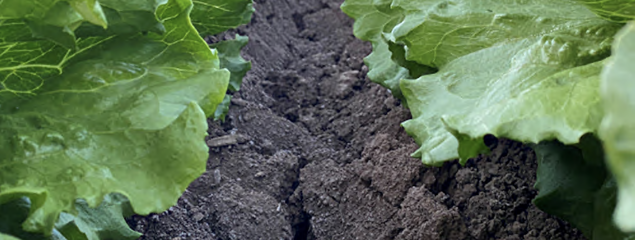
Soil Health
Fertilizer Guidelines for Vegetable Crops in Arizona
Crop Fertilizer Guidelines (3)
Potatoes (3.10)
Less than 5,000 acres of potatoes are produced in Arizona, and most are “Atlantic” types for the potato chip industry (Figure 3-10-1). Seasonal nitrogen (N) accumulation by potatoes is approximately 200 lbs N/acre, and amounts removed in the harvested tuber is over 120 lbs N/acre (7, 12, 13). Potato yields are usually maximized at less than 250 lbs N/acre in Arizona depending on residual soil nitrate.
Pre-plant N applications should be based on a pre-plant nitrate-N test, and recommended rates will vary from 10-40 lbs/acre depending on soil test level and rates of monoammonium phosphate (MAP) applied as a pre-plant phosphorus (P) fertilizer (Section 2.1). The N can be applied with the pre-plant P fertilizer. Alternatively, early-season N might be applied through sprinklers if used for irrigation.
If potatoes are furrow irrigated and most in-season N application is by side dress application, the N rate to be applied at side-dress should be based on a pre-side dress nitrate-N test. The required application rate depends on the difference between the soil test level and the minimum required threshold of 30 ppm. Approximately 4 lbs of N/acre needs to be added to increase the soil test nitrate-N by 1 ppm. Fertigation in furrow water later in the season should only occur if soil nitrate-N levels fall below 20 ppm before 2-inch tubers are produced.
Currently, most potatoes in Arizona are produced under center-pivot or linear-move irrigation. These systems allow for a more frequent, lighter application of N that is more in line with anticipated crop N uptake. Seasonal N rates can be adjusted based on results of in-season soil nitrate-N tests. The guideline considers a soil nitrate-N test level of 20 ppm as the lower threshold below which N fertilizer application is required. N fertilizer needs to be applied at a rate of 4 lbs/acre to raise the soil nitrate-N level by 1 ppm. Alternatively, the in-season petiole N tissue testing program outlined in section 4.2 can be used to guide in-season N fertilization. The N fertilization should be completed by the formation of 2-inch tubers. Growers have had success using petiole nitrate-N test (Section 4.2).
Potatoes in Arizona will respond to P fertilizer up to an Olsen P soil test of 20 ppm (Figure 3-10-2 and Table 3-10-1). However, because potatoes in Arizona are planted into cool soils in February, a starter P is usually recommended at Olsen P soil test levels exceeding 20 ppm. Pre-plant P, or starter P, can be applied into the same trench as the potato seed pieces.
Some potatoes are produced on sandy soils testing less than 150 AA K, and growers have used potassium (K) fertilizers as recommended. The author of this report has not done potato research on soils testing less than 150 AA K and has no basis to modify this default threshold for the Western United States (Section 3.2). Leaf K concentrations greater than 4.0% are considered sufficient (Section 4.3).
Recently, response of potato to zinc (Zn) has been observed in Arizona, and testing for soil DTPA Zn levels is recommended (Section 2.3). Leaf tissue Zn concentration can also be monitored where concentrations greater than 40 ppm are considered adequate (Section 4.3).

Figure 3-10-1
Potato field near Maricopa, AZ produced under linear move irrigation system

Figure 3-10-2
Relationship between soil test P and relative response of potato to P fertilization. Data collected from multiple field experiments conducted in Central Arizona in 2011 to 2018.

Table 3-10-1
Potato P fertilizer guidelines by pre-plant Olsen P soil test.
1 The fertilizer label is in % P2O5 and recommendations are made as P2O5. However, we have expressed rate as P (44% P2O5) for data presented in this presentation and the recommended rates in this convention are shown as well.
2Approzimately 25% less P fertilizer can be used when the P fertilizer is applied in trench with seed pieces instead of broadcast and disked before planting.

